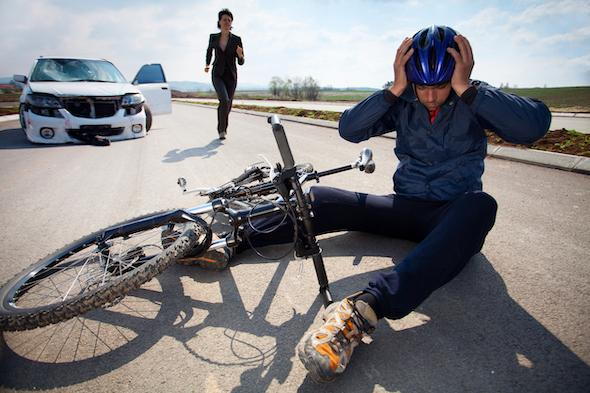
Bicycle accidents can be extremely scary and dangerous. Without the protective body barriers of a car or truck, an auto accident involving a cyclist can cause extensive injuries leading to lawsuits. But when a biker is hit, or loses control due to a distracted driver’s carelessness or lane change, who is at fault?
Hitting someone on a bicycle can be tragically scary—and with bikes often hard to see on the roads or bike lane, accidents involving cyclists are a common occurrence.
When we’re riding in a car and the other driver has the right of way, we know to let them make a move first. But the same is true for bicycles. Motorists often don’t include cyclists when they are yielding to a right of a way, causing them to hit a bike and trigger substantial injuries. This type of accident is so common, it actually accounts for a large majority of bicycle accidents each year.
When a light turns green, our first instinct is to go. What motorists often forget to look for is cyclists in their path — whether they are crossing a cross walk or passing through a light. If a motorist fails to notice a bike and hits them, the motorist is most likely to be at fault, assuming the cyclist was following the rules of the road.
This is called a right hook and happens when a motorist passes a biker on their left and proceeds to make a right turn into the bike’s path. This can easily happen by either not seeing the cyclist or misjudging their speed and thinking they are further behind than they actually are.
In most states, a cyclist is considered the same as a motorist when riding on roads, meaning they must follow all the same rules that cars do. Because of this, the cyclist often has some fault for an accident, even if there are major injuries sustained.
When we start to get momentum on our bicycle, the last thing we want to do is stop. But when on main roads, we must follow the rules, meaning frequent stopping is necessary. If a cyclist fails to stop, or stops, but not long enough to let a car pass, and an accident occurs, the cyclist will usually be at fault.
This is one of the most dangerous things a person on a bicycle can do when sharing the road. Before an accident even occurs, a cyclist that rides against traffic is already breaking the law, so it’s clear to see why they would be at fault if an accident does happen. This can cause accidents with other cyclists, increasing your chances of injury for not only yourself, but all other riders.
Surprisingly, this happens just as often on the road as it does in a parking lot or shopping center. If a cyclist has a stop sign and a car does not, when a cyclist rides out in front of the car, the cyclist will most likely be at fault for the accident. However, there can be more than one party at fault for an accident. If the fault is shared, the injured cyclist can still receive compensation for his injuries.
While these are some of the main reasons accidents occur between bicycles and cars, there are many other instances, such as hitting a cyclist while opening your car door when parked or causing a cyclist to lose control due to hazardous driving practices. Whether you are driving a car or traveling via bicycle, it’s important to always follow the rules of the road and keep an eye out for all other vehicles.
Need A Bike Injury Claim Lawyer?
For more information, call one of our personal injury specialists near you for help or we will come to you if you prefer.
Michigan personal injury law office at (248) 352-2110, or 1-866-HIRE-JOE
If you would like to email us, please visit our contact page.
